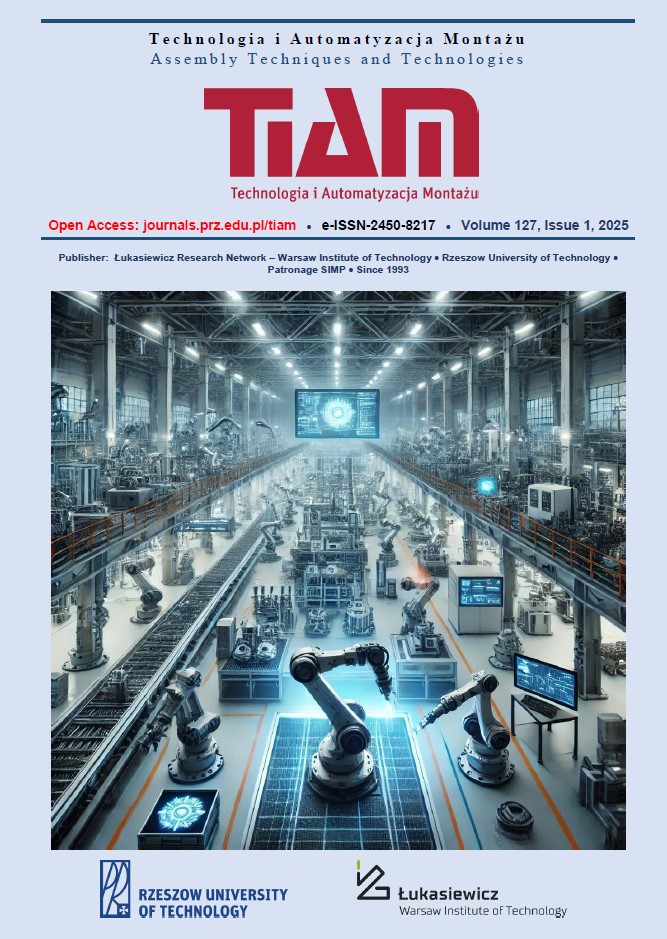Abstract
Compressed air is a very important energy medium in industrial processes. Maintained at a pressure higher than atmospheric pressure, it is one of the most commonly used working mediums. Leaks in pneumatic systems, inappropriate pressure, improper use of components, etc. are responsible for losses of produced compressed air. Pneumatic actuators, which are key in this respect, are exposed to internal and external leaks, which leads to an increase in their extension and retraction time, a decrease in the force achieved on the piston rod, and in the case of large leaks - to their stopping, causing a failure and necessary downtime of the machine or the entire production line. The article addresses the problem of leaks in pneumatic actuators used within automated production systems. The specificity of operation of pneumatic actuators, problems with their leaks, and available methods of their detection are discussed. For the needs of the tested production system, an original method for detecting leaks in pneumatic actuators was developed, the operation of which was verified using a simulation model in the Simulink environment. The performed analysis allowed to confirm the correctness of the developed method.
References
Abela K., Refalo P. (2022). Analysis of pneumatic parameters to identify leakages and faults on the demand side of a compressed air system, Cleaner Engineering and Technology, Vol. 6,100355. https://doi.org/10.1016/j.clet.2021.100355.
Dudić S., Ignjatović I., Šešlija D., Blagojević V., Stojiljković M.. (2012). Leakage quantification of compressed air on pipes using thermovision. Thermal Science, 16(2), pp. 571-581. https://doi.org/10.2298/TSCI120503191D
Feng, Z.G., Zhang, X.J. (2013). Study on fault simulation for pneumatic actuator model. 3rd International Conference on Mechatronics and Intelligent Materials (MIM 2013), Mechatronics And Intelligent Materials III, PTS 1-3, 706-708. https://doi.org/10.4028/www.scientific.net/AMR.706-708.1025.
Fracczak L., Nowak M., Koter K. (2021). Flexible push pneumatic actuator with high elongation. Sensors and Actuators A 321, 112578. https://doi.org/10.1016/j.sna.2021.112578.
Guenther T., Kroll A. (2016). Automated detection of compressed air leaks using a scanning ultrasonic sensor system. IEEE Sensors Applications Symposium, pp. 1-6. https://doi.org/10.1109/SAS.2016.7479830.
Hu W., Mutlu R., Li W., Alici G. (2018). A structural optimisation method for a soft pneumatic actuator. Robotics 7(2), 24. https://doi.org/10.3390/robotics7020024.
International Organization for Standardization (2018). Pneumatic fluid power – Cylinders with detachable mountings, 1 000 kPa (10bar) series, bores from 32 to 320 mm - Basic, mounting and accessories dimensions. (ISO 15552:2018). https://www.iso.org/standard/66921.html.
Jaafar M.A.I.B., Abas A., Khairil K.A. (2024). Real‑time leakage predictions of pneumatic controlled actuator during cycle test using machine learning, The International Journal of Advanced Manufacturing Technology 134: pp. 4577-4592. https://doi.org/10.1007/s00170-024-14362-5.
Kroll A., Baetz W. i Peretzki D. (2009). On autonomous detection of pressured air and gas leaks using passive IR-thermography for mobile robot application. 2009 IEEE International Conference on Robotics and Automation, Vol. 1-7, pp. 998-1003. https://doi.org/10.1109/ROBOT.2009.5152337.
Kucharski S., Makiewicz S., Katz T., Starzyński G., Ranachowski Z., Woźniacka S. (2023). Evaluation of fatigue damage of a railhead using an indentation test, acoustic methods and microstructural observations. International Journal of Fatigue, Vol. 167, Part B, 2023, 107346, https://doi.org/10.1016/j.ijfatigue.2022.107346.
Kurmyshev E., Jiménez M. i Castaneda C. (2020). Experimental study of double-acting cylinder. Experimental Techniques, 44(2), pp. 355-367. https://doi.org/10.1007/s40799-020-00359-8.
Loska A, Moczulski W, Wyczółkowski R, Dąbrowski A. (2016). Integrated system of control and management of exploitation of water supply system. Diagnostyka. 17(1), pp. 65-74.
Mahmoud H., Mazal P. (2018). Diagnostics of the function of pneumatic actuators using acoustic emission. Brno University of Technology Vutiom Press, Brno.
Nazarchuk Z., Skalskyi V., Serhiyenko O. (2017). Acoustic emission. Methodology and application. Springer International Publishing.
Parr E. A. (2011). Hydraulics and pneumatics: A technician’s and engineer’s guide. 3rd Edition, Elsevier Ltd., Burlington.
Rottländer H., Umrath W. i Voss G. (2016). Fundamentals of leak detection. Leybolg GmbH, Cologne.
SMC Corporation, Air Management System – Operation Manual. SMC Corporation. https://www.smcworld.com/upfiles/manual/en-jp/files/PFxx-OMA1007.pdf.
SMC Corporation, Automatic leak detection system. SMC Corporation. https://static.smc.eu/binaries/content/assets/smc_global/solutions/packaging/alds-a_leaf_en.pdf.
Szenajch W. (2016). Napęd i sterowanie pneumatyczne. Wydawnictwo Naukowe PWN, Warszawa.
Tomasiak E. (2001). Napędy i sterowania hydrauliczne i pneumatyczne. Wydawnictwo Politechniki Śląskiej, Gliwice.
Whitlam, Liquid Gas Leak Detector Spray, Talon, (2021). https://www.jcwhitlam.com/Product/1/90/139#.
Zhu H., Wang Z., Wang H., Zhao Z. i Xiong W. (2023). Fault diagnosis of two parallel cylinders in pneumatic system with a minimal number of sensors. Electronics 12(15), 3261. https://doi.org/10.3390/electronics12153261 Electronics, t. XII, nr 15, 2023.

